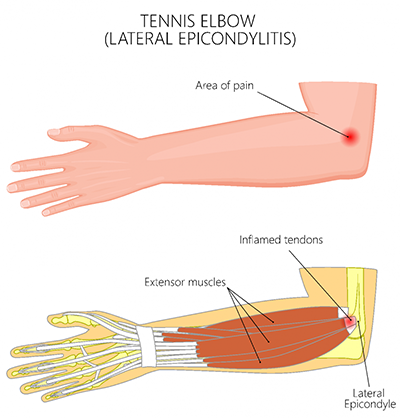Tennis elbow
Tennis elbow is an injury caused by the repeated strain of gripping or twisting your wrist and arm.

What is tennis elbow?
Tennis elbow, also known as ‘lateral epicondylitis’, is inflammation around the joint, resulting in pain in the outside of the elbow, particularly with movement.
What causes tennis elbow?
Tennis elbow is caused by repetitive strain of your hand or wrist and causes pain or swelling in the tendons on the outside of your elbow. This can make it painful to use the affected arm.
Despite its name, it is not only caused by playing tennis but can be caused by any repetitive activity that puts strain on your wrist and arm.
It is similar to ‘Golfer’s elbow’, which causes similar symptoms around the inside of the elbow and is caused by repetitive use of the flexion muscles that attach around the elbow.
What are the symptoms of tennis elbow?
Symptoms of tennis elbow include:
- pain and tenderness - this is caused by the tendons in your forearm muscle becoming inflamed and is usually experienced on the outer side of your elbow
- pain on gripping small objects (for example, when writing),
- pain when lifting, bending or twisting the arm.
While painful, there are no long-term effects of tennis elbow.
How is tennis elbow treated?
Tennis elbow is known as a ‘self-limiting’ condition, meaning that it often resolves on its own with supportive treatment, including rest and support, medication and physiotherapy to improve symptoms.
In 90% of cases, episodes resolve within 1 year. If the symptoms are not resolved after 1 year of supportive management, further options, including surgery (tennis elbow release), can be explored. Tennis elbow can recur in 8.5% of cases; these cases are also often suitable for surgical treatment.
Alternative treatment options
Whilst surgery is a viable option, there are several alternatives, including continued physiotherapy, steroid injections, alternative injections and acupuncture for those who wish to avoid surgery.
- Steroid: Steroid injections are often used in managing arthritis, and can provide short-term symptom relief. However, there have been some links to an increased rate of recurrence.
- Physiotherapy: Some studies have shown that physiotherapy confers long-term benefits for pain relief. Physiotherapy based on simple exercises that help to strengthen the muscles around the joint has been shown to be particularly helpful in rehabilitating tennis elbow. Eccentric exercises have also been shown to reduce pain, improve function and maintain the range of movement in the joint.
- Supports: It is often recommended to use orthotic straps and splints as support alongside physiotherapy, with the idea that reducing muscle activity and offloading the painful part of the joint helps to provide symptom relief.
- PRP (Platelet-Rich Plasma): These contain blood products, such as 'platelet-rich plasma', and have been shown to be a viable alternative to surgery in tricky-to-treat tennis elbow.
- Botulinum: This will temporarily paralyse the affected muscles, followed by gradual re-loading of the joint to restore function.
- Hyaluronan gel: Also used in arthritis, some early research has shown that these compounds can assist in tendon healing
- Shock wave therapy: This technology is mainly used to break down small kidney stones made of calcium compounds. In cases where there is calcification of the tendon, shock wave treatments can be theoretically useful, but they do not help in the majority of cases of tennis elbow.
- Acupuncture: An alternative form of pain relief, acupuncture has been shown to give short-term benefits in the case of tennis elbow, and can be used in combination with other treatments (topical NSAIDS, physiotherapy etc.).
